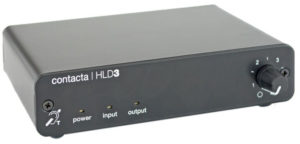There are two basic kinds of amplifiers-voltage amplifiers and current amplifiers. Amplifiers designed specifically to work with loop systems (like the Contacta HLD3) are current amplifiers. Amplifiers that drive normal loudspeaker systems are voltage amplifiers.
Current Amplifiers
If you are setting up a loop system, using a current amplifier is much easier than using a voltage amplifier because you don’t have to worry about things like matching the impedance of the amplifier to the loop like you have to do with voltage amplifiers. With current amplifiers the length of the loop is not important. Using too long a wire (too big a loop) will just result in a weaker signal. Therefore, for best results, match the size of the loop to the manufacturer’s recommendations for proper signal strength. Likewise, using a particularly small loop won’t damage or burn out your current amplifier like you can do with a voltage amplifier. Furthermore, you can use a single wire loop without any problems. This is simpler to install than a double wire loop. Order one of the best little current amplifiers, the Contacta HLD3.
Voltage Amplifiers
With voltage amplifiers, loop length, thickness of the wire and the amplifier output impedance are all important. If you do not do things right, you can burn out your amplifier. With a voltage amplifier, using too short a wire will result in too low a resistance and you can quickly burn out the amplifier unless you add a resistor of the proper value into the loop circuit. Doing this wastes power. Likewise, if you use too long a wire or too thin a wire, you may increase the resistance in your loop. Again, you are wasting power rather than putting the full power of your amplifier into the loop. In order to roughly match the resistance and impedance, it is advisable to use a double wire loop, rather than the single wire loop you can use with a current amplifier.
Making a Voltage Amplifier Loop System
If you still want to make your own loop system using a voltage amplifier and are not afraid of some technical discussion, here is how you can do it. Note: you do this at your own risk. Use the following information as a guide only. A relatively good, yet cheap voltage amplifier suitable for a home loop system is the Radio Shack 40 watt P A Amplifier (Catalog No. 32-2054) for $99.99 in the USA. This amplifier requires a total impedance of between 4 and 16 ohms. Thus, you need to design the impedance of your loop system to fall between these two values. Impedance is the sum of both the reactance of an AC circuit and its DC resistance. Both resistance and reactance are measured in ohms. Impedance is difficult to measure unless you have the right equipment and are knowledgeable in electronics. The DC resistance of the loop varies according to the following two principles. The larger the wire the less the resistance. The smaller the wire, the higher the resistance. Wire size is measured as wire “gauge.” The bigger the number, the smaller the wire. The smaller the wire gauge number, the bigger the wire. Thus 0 gauge wire is a big wire with a small resistance as compared to 18 gauge wire which is much smaller wire with a higher resistance. (As a matter of interest, 14 gauge wire is used in standard house wiring circuits.) Using an ohmmeter, you will discover that the resistance of a 200 foot loop (100 feet of speaker wire in a double loop configuration) of 18 gauge wire is about 1.4 to 1.5 ohms. The impedance of this loop will be about 5 ohms. Thus using a 200 foot 18 gauge double-wire loop should be safe for this amplifier and should produce a good signal. Learn how to make a double wire loop system.



Some new good quality digital power amps are actually current amplifiers. they drive less than .5 ohms. The power supply adapts for the current draw. Plus the quality is much better.
Jerry,
Having severe hearing loss, I am personally interested in experimenting with loop design. Please name and source the amplifiers of which you speak, so that I may investigate and possibly acquire a suitable amplifier for my DIY designs.
Thanks for your help,
Barry